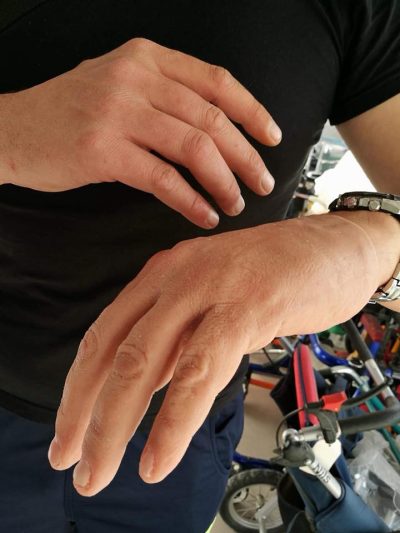Myoelectric are the most advanced prostheses for upper limb amputation and they are used for finger, transradial and transhumeral amputation and for wrist, elbow and shoulder disarticulation. The use of battery and electrodes are required for their proper function.

I digit quantum
Μyoelectric prosthesis for finger(s) amputation where the level of absence is distal to the wrist and proximal to the metacarpophalangeal joint.
It operates with a microprocessor and one or two electrodes. Its operation is proportional, which means that the speed and strength of the extension and flexion of the fingers depends on the strength of the command that the user will give with his muscles. It has 32 different grips that can be adjusted by the prosthetist and the user through the special application on the smartphone.
I-limb
Myoelectric proportional hand with 5 motors and movement in all five fingers
It is available in the following versions:
- -i limb access with 12 different grips
- -i limb access titanium with 12 different grips and titanium fingers
- -i limb quantum with 36 grips, electrically rotating thumb and titanium fingers
- -i limb ultra with 18 grips, electrically rotating thumb, titanium fingers and mechanical wrist movement.
- i limb ultra quantum with 18 grips, electrically rotating thumb, titanium fingers and mechanical wrist movement.


Be bionic
Myoelectric hand with movement in all 5 fingers, 14 grips and mechanical wrist movement.
Michelangelo
Myoelectric hand with 7 handles, movement in all 5 fingers electrically rotating thumb and wrist.


Greifer dmc vari plus
Greifer is a myoelectric hand that helps the user to work with precision and enables a strong grip that making easier the lifting of the heavy objects. It provides different grip tips (wide, narrow or rubber coated) which allow further customization for specific tasks. The additional LED lamp perfectly illuminates the work area. The handle joint can be bent in any direction (approximately 45 degrees), minimizing harmful compensatory movements.
MyoHand VariPlus Speed
Myoelectric hand with movement in 3 fingers. Its operation is proportional, which means that the speed and strength of the extension and flexion depends on the strength of the command that the user will give with his muscles.


Myokinisi hand
Myoelectric hand with 3 fingers movement. Its operation is proportional, which means that the speed and strength of the extension and flexion depends on the strength of the command that the user will give with his muscles.
System Electric Hand Digital Twin
Myoelectric hand with 3 fingers movement. Provides consistent speed and strength in extension and flexion of the thumb, index and middle fingers.

Ergoarm electronic plus
Myoelectric elbow Ergoarm electronic plus locks and unlocks in a flexed or extended position with the user’s myoelectric signals. The function Automatic Forearm Balance (AFB) supports the flexion of the elbow by storing energy during extension.


Espire hybrid
Myoelectric elbow espire hybrid locks and unlocks in a flexed or extended position with the user’s myoelectric signals
Dynamic arm
The dynamic arm myoelectric elbow provides electrically controlled elbow flexion and extension movement with the user’s myoelectric signals.


Espire pro
Μyoelectric elbow espire pro provides electrically controlled elbow flexion and extension movement with the user’s myoelectric signals.
Myo plus pattern recognition
Myo plus pattern recognition is used for transradial amputations.
The muscles in the hands rarely work alone to perform a movement. Every time we move our hands, many muscles make coordinated contractions, and each muscle emits its own myoelectric signal. Each different movement results in the creation of a unique pattern. The myoelectric signals are detected by 5 to 8 electrodes which are placed inside the prosthetic socket and are in contact with the surface of the stump. The electrodes transmit the myoelectric signals to the microprocessor and each pattern is translated into the corresponding movement from the myoelectric palm. With pattern recognition, these patterns are decoded in real time, and the result is being reflected in the myoelectric hand.
Body powered prostheses.
Body powered prostheses are used for transradial, elbow disarticulation and transhumeral amputations. For the operation of the prosthesis, an external harness is required. The terminal device can be selected according to the needs of the user.


Cosmetic prosthesis
Cosmetic prostheses can be used at any level of upper limp amputation. Advances in silicone technology over the last 20 years have made it possible to reproduce almost all the anatomical features of the amputated limb in the new prosthetic limb.
Rehabline is one of the few prosthetic and orthotic rehabilitation clinics in Europe that has a specialized cosmetic silicone laboratory in its facilities and applies the “siliconeskin” technology for the cosmetic reconstruction of upper and lower limbs based on the anatomical characteristics of each user.
